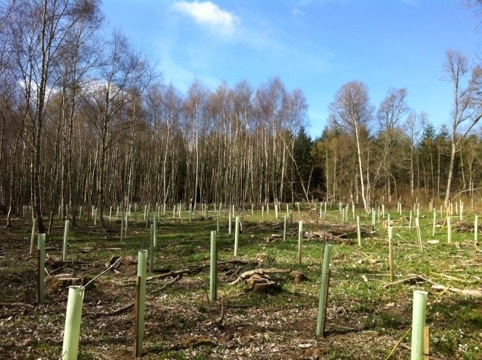I recently returned from a conservation weekend at Hazel Hill wood, the sixth such weekend in which I have participated, and a visit that prompted some more thoughts on ways we can teach sustainability in universities.

The wood is a nature sanctury and is maintained by teams of volunteers to who congregate over a weekend to plant, uproot, tend, meand and sing songs aronud the camp fire.Being a relatively experienced hand at the wood, I am starting to benefit from seeing how the site has changed over time (more about that in a minute). It also means that I can be left to look after a number of the weekend’s projects now that I have a better idea of how things work.
Particularly satisfying this weekend was helping to set up a greywater system that uses the water which drains from the wood-fired hot tub to supply the irrigation system in the tree nursery. We also spent a morning watering over eighty saplings that stand to suffer from the predicted drought conditions this summer. A handful of these trees were self-germinating saplings that we had protected last year. It was great to see them surviving. In the evening we visited the bee hives. Two years ago there were two colonies on site; now there are nineteen. The bee keeper never fails to keep us enthralled with the intricacies of how bee colonies behave. Incredible.
Slow Learning
Watering trees gives you lots of time to think, and I caught myself thinking about how much I have come to understand about Hazel Hill wood since I first visited three years ago. On any single visit, you can learn a whole range of things about the flora and fauna, techniques for looking after trees etc. But a whole new dimension opens up over a period of regular visits: you can see how plants develop; you start to develop an appreciation of the timescales over which woodlands develop; you can see the impact of actions that you have taken on previous visits. On a single visit, you may learn the name of a particular species of tree; over a number of years you can see how that tree spreads its seeds, how these shoot up, and crowd out other species (I’m talking here about sycamores). Above and beyond the simple fact of observation, I feel somehow affected by this knowledge; that it will change the way I feel towards that environment, and others.
I think you could call this process ‘Slow Learning’, and I think it is particularly appropriate for learning about ecosystems. And of course it sounds very similar to the philosophy of permaculture. But in general I think it can be characterised by patient observation of a long period of time. It is about observing change; but more significantly I think it is about somehow feeling that change on an emotional level (otherwise, you could simply read about the changes that happen, say in a woodland environment-but it wouldn’t have the same impact).
I recently researched and wrote a report for universities with suggestions for how sustainability education for undergraduate engineers could be improved (download it here). And whilst I talked about the importance of getting involved with community projects (local conservation initiatives, for example), the reason was to get people involved with other community stakeholders. My experiences this weekend suggest an added benefit of regular involvement in a conservation project is this process of Slow Learning that I have described here – participants get the chance to not only see change, but experience it, which in turn may positively influence the way they behave with respect to their environment.


4 Comments
4 Pingbacks